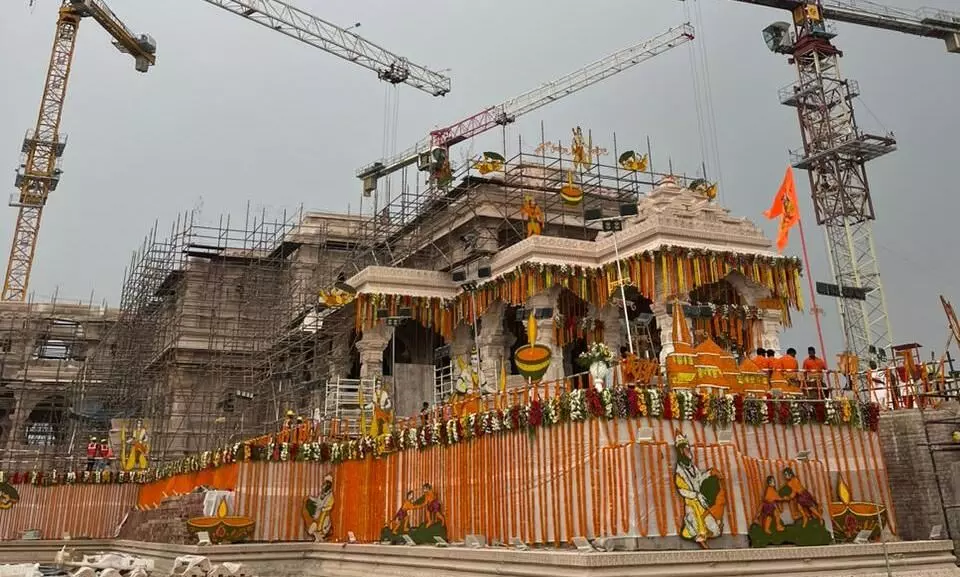Tourist arrivals in Ayodhya projected to zoom 300% after Ram Mandir opening
With a 300 per cent rise in the number of pilgrims visiting the soon-to-be-opened Ram Temple, the south-central Uttar Pradesh township is expected to emerge as the world’s most popular pilgrim centre.

Source: X
New Delhi, Jan 2: Following the inauguration of the newly constructed Ram Temple and improvements in infrastructure in Ayodhya, the number of tourists visiting the site commemorating the birthplace of Lord Ram is expected to reach humongous levels, say experts.
“The temple opening on January 22 will be a game changer for Uttar Pradesh and India. We expect a three-fold increase in the number of pilgrims to Ayodhya once the temple opens to the public,” PP Khanna, the president of the country’s largest domestic tourism body, the Association of Domestic Tour Operators of India (ADTOI) & Director of the travel agency Diplomatic Travel Point, told The Assam Tribune in New Delhi.
Ayodhya, located 155 km from the Uttar Pradesh state capital Lucknow, attracted over 20 million visitors at the last count.
In comparison, other world-famous pilgrim sites such as Vatican City, the headquarters of the Roman Catholic Church, attracted 5 million plus tourists, the holiest Islamic site Mecca 2.5 million and Jerusalem, which is revered by all three Abrahamic faiths, viz. Judaism, Christianity and Islam, 3.5 million pilgrims.
Thus, in years to come, Ayodhya is likely to emerge as the largest pilgrim centre globally.
“A substantial part of this pilgrim traffic will spill over to other temple towns like Varanasi and Chitrakoot in the state,” added Khanna.
The creation of new infrastructure is also expected to significantly boost footfall. On December 30, Prime Minister Narendra Modi inaugurated the revamped railway station as well as a new airport in the city. Modi flagged off one Vande Bharat and Amrit Bharat service each to put the town on Indian Railways’ semi-high-speed rail network.
Develop responsibly to maximise benefits
Given the impending demand, India’s leading carriers, IndiGo and Air India, have already launched multiple flights to the city. The country’s largest carrier by fleet size and market share, IndiGo, has launched flights from Delhi, Mumbai and Ahmedabad.
“These new routes will significantly promote travel, tourism, and trade in the region, contributing to economic growth and providing tourists direct access to Ayodhya through the IndiGo network across India as well as overseas,” stated Vinay Malhotra, Head of Global Sales at the carrier, in a statement.
Similarly, Air India Express has launched flights from Delhi, Bengaluru and Kolkata.
Aloke Singh, Managing Director, Air India Express, said: “Given that these cities are major hubs on our network, they will provide pilgrims and tourists from the northern, southern and eastern parts of India with convenient one-stop itineraries to reach Ayodhya.”
This infrastructure upgrade holds significant potential for the city and Uttar Pradesh’s tourism sector.
“Estimates suggest the tourist influx could rise from 8 to 10 million annually, impacting the state’s current Rs 44,000 crore tourism industry. Improved connectivity is likely to attract businesses and investments, driving economic growth and potentially creating numerous jobs,” averred Jagannarayan Padmanabhan, Senior Director at CRISIL Market Intelligence.
Padmanabhan was, however, quick to point out the importance of responsible development to ensure environmental sustainability and equitable benefits for local communities.
“Ayodhya's transformation into a major tourism and economic hub requires careful planning and execution to maximise its potential for all stakeholders,” he said.
